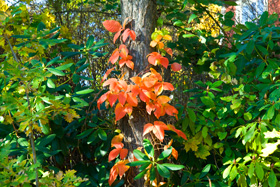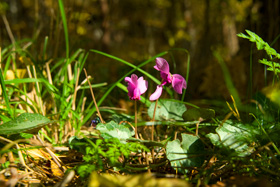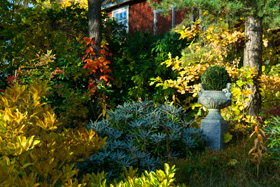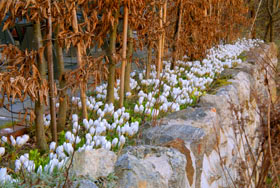"Gardening is a way of showing that you believe in tomorrow". Unknown
October 2008
It’s the beginning of October 2008, and it’s the same story every year. Autumn arrives all at once – think how the garden can change in only a few days! It’s an Indian summer just now, planting time and time to stand back -if only for a few moments - and gaze upon the garden; time to reflect on a gardening season which is about to enter its winter slumber.
There’s so much to do in the garden this time of year that there’s really no time to sit back and enjoy it. And there’s still so much in bloom in our little garden.
The colours are exploding! The fruits, the rosehips, and the wonderful autumnal colours – such a contrast with the exotic Agapanthus that are still in bloom (admittedly past their best, but still blooming).
The Summer Snow clematis is also still clinging on with a few last flowers, while the Anemonaes are in full vigour, not to mention the Black-Eyed Susans (Rudbeckia, named by Carl Linné in honour of the Swedish naturalist Olaus Rudbeck). The trees are laden with pears and apples – autumn has begun.
Both harvest time and planting time –that’s a good way to summarise the beginning of October. There’s such much to get down into the ground. Indeed there is. I’m constantly surprised over what can fit into a small garden – thousands of bulbs!
You might think that I’m exaggerating, but the fact is that I plant 3-4,000 bulbs each autumn, and have done so for many years. Some of the bulbs disappear over time, but most come back year after year. For example, a single, tiny botanical crocus bulb will yield 3-4 flowers. Botanical crocuses give a true mass effect, and I adore them. They flower a little earlier than the Dutch crocus, arriving as they do in the springtime when a splash of colour is just the tonic after the long winter months. The thing to bear in mind when planting such early-flowering bulbs is to plant them in a spot where the sun first melts away the winter snow.
This year I’ve planted a couple of thousand botanical crocuses as well as a thousand Miss Vain Dutch crocuses and a thousand Blue Pearl snow crocuses. With their soft, lustrous, light blue flowers, these are among the first to bloom. So far this season I’ve also planted 1,500 Dutch Jean D´arc giant crocuses, 200 Carnegie white hyacinths, and a couple of hundred summer snowflakes, Leucojum aestivum Gravetye Giant. 100 Maureen tulip bulbs are still waiting to be planted, as are a hundred lily-flowered White Triumphator tulips, which will produce pure white flowers carried on graceful stems of up 60 cm in height. Yes, there’s a lot to get down in the soil, but most of the planting is now done. It’s no good just ordering bulbs and believing that everything will take care of itself –everything’s got to go down in the ground. A lot of work…but the results will make it all worthwhile.
I love bulbs. In some way, they’re one of life’s wonders. Carefully press that small bulb into the ground, cover and water it a little and reflect: come the springtime it will be a life, alive. It’s incredible: nature’s wonder in a tiny bulb; a bit like Blake’s world in a grain of sand.
Where we live in Sweden it is, in fact, possible to keep a garden going quite long into the autumn. There are still some perennials that I’m waiting for, but one which at present is causing me to stop and stare in wonderment is the white bugbane, Cimicifuga Atropurpurea, in our large border, which began flowering at the end of September and keeps going strong well into October. The stately, two-meter high Joe Pye weed, Eupatorium purpureum, is also still in bloom.
I remember the first years we had a garden in Sweden. Back then, I more or less forgot about the autumn and focused on the summer. But this has changed over the course of time; when you’ve an interest, it’s very important to be thinking forward throughout the season.
During the past few years, the autumn has come to play an important role for me when it comes to perennials, and I’ve attempted to blend in autumn perennials so as to prolong the season. The chalk-white autumn phlox, Phlox paniculata Fujiyama, which I’ve talked about earlier, is still going strong, and the Virgina Creeper, Parthenocissus quinquefolia, has now begun to display its fantastic colours. There’s so much to think about: think colour, think perennials!
But first and foremost –in the autumn, don’t forgot the spring; now’s the time to get the bulbs in the ground. Each autumn, I run around with a notebook and pen, planning for the future. I became almost hysterical with joy when my bulbs arrived recently. I thought to myself: now it’s just a question of getting started. I know exactly where I’m going to plant them. There’s no point in going round the garden and thinking, “Where should I plant this bulb, where should I put that one?” My planting has already been planned since the beginning of May. Each year, I begin planning as early as March-April. With pen and paper in hand, I go round the garden and give it a good, long look. What can I put here? Is something missing there?
Then, when autumn arrives, it’s just a question of reaching for the notebook again, and reflecting for a moment over the fact the season seems to have just flown by. How lucky to have everything down on paper: start to the left, one step to the right, three paces to the left, etc. so that you know precisely and can plant in peace, without disturbing other small bulbs.
Well, I’ve no time to sit around now, I’ve got to get out and plant! But before doing so, I’ll end this chronicle by going outside to hear the birds singing, and take a few moments to sit beneath a Virginia creeper and admire its blazing colours.
What an explosion of colour autumn can bring. Don’t forget the autumn!
A Gentleman Gardener
Ps. and don’t forget the birds, either: start feeding them, empty their nesting boxes, and fill the birdbaths
Next time: It might be November, but the garden season is far from over



